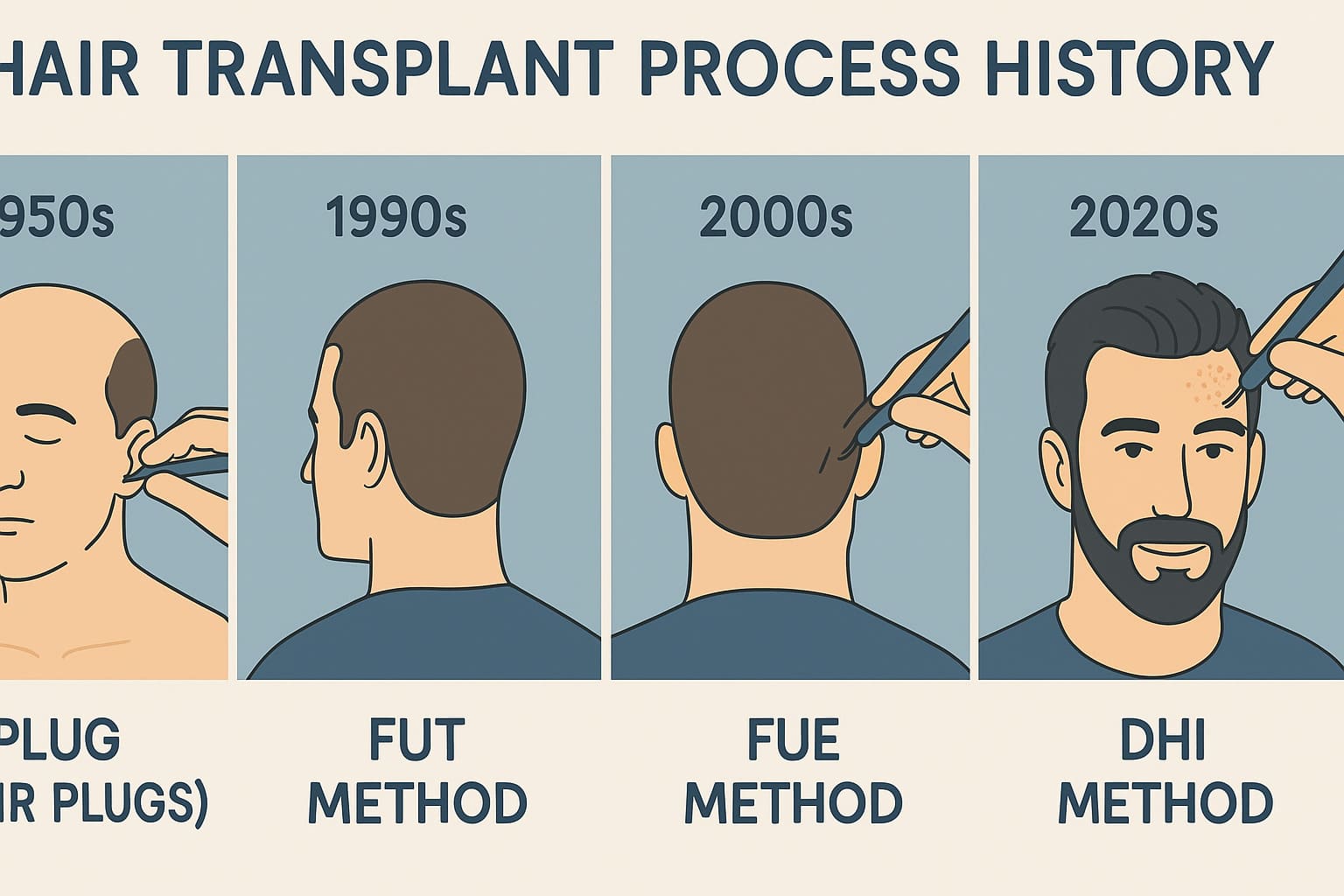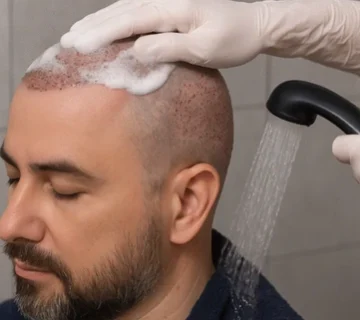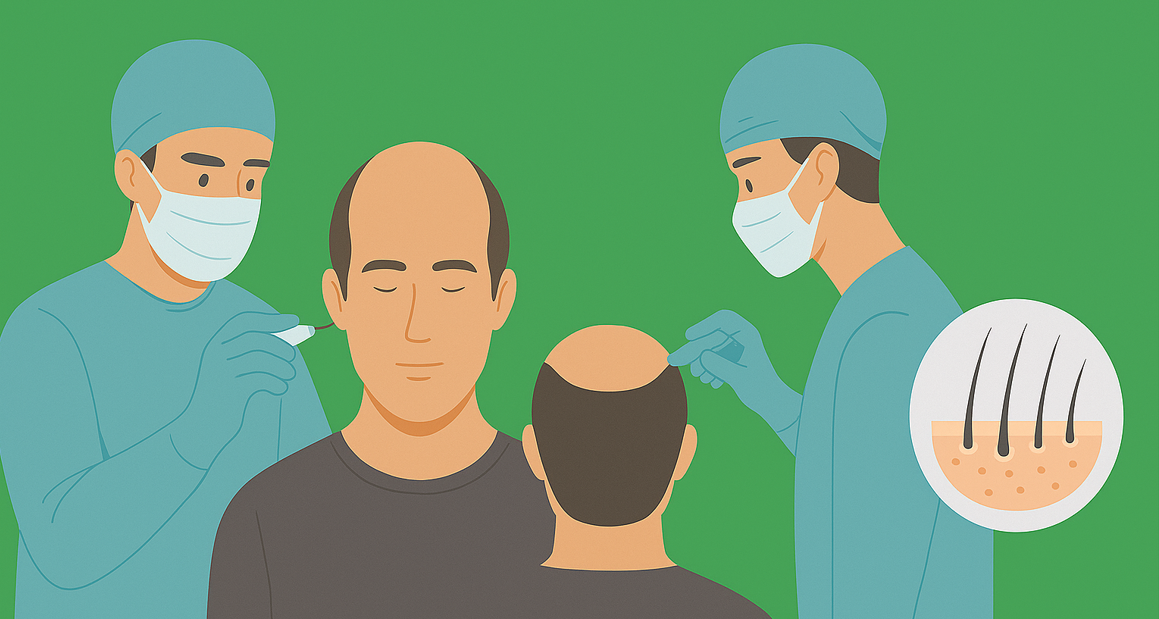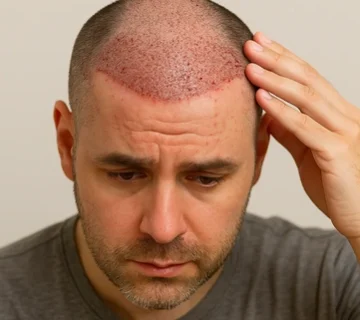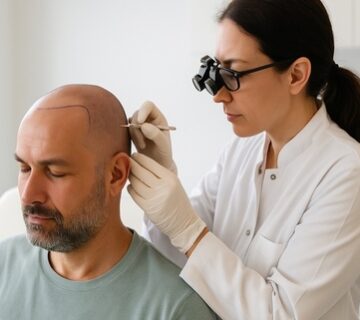What Is Hair Transplant? Understanding the Basics
Hair transplant is a surgical technique that offers a permanent solution for hair loss by transplanting healthy hair follicles to areas experiencing thinning or baldness. With over 74,000 monthly searches, there is a strong demand for accurate and comprehensive information.
This procedure addresses common questions about the cost, method, and effectiveness of hair transplant and clarifies major misconceptions about pain, safety, and long-term results. The aim is to empower users with neutral, expert-backed data for informed decision-making.
Definition and History of Hair Transplant
Hair transplant is a surgical method of moving hair follicles to areas affected by baldness or thinning. First performed in the 1950s, the technique has significantly evolved, leading to modern FUE and FUT methods; the DHI technique, which complements FUE, is also frequently used. With over 700,000 procedures performed annually worldwide, growing trust in the method is evident. Experts highlight graft survival rates of over 90% with current techniques. These minimally invasive procedures help restore confidence and a natural appearance.
Who Should Consider Hair Transplant? Indications and Suitability
Ideal candidates are individuals with stable donor hair areas suffering from male or female pattern baldness. Approximately 35 million men and 21 million women in the U.S. experience hair loss. Doctors recommend hair transplants for those who do not respond to medical treatments. The best results are seen in adults over 25 with realistic expectations about hair density. A comprehensive scalp evaluation ensures suitability and addresses the root causes of hair loss.
Types of Hair Loss Treated by Hair Transplant
Hair transplant is effective in cases of androgenic alopecia, scarring alopecia, and some traction alopecia. It includes receding hairlines, crown thinning, and cases following trauma or surgery. It is not suitable for diffuse hair loss or insufficient donor hair supply. Results are improving for various hair types, including Afro-textured and female patients. Expert guidance is essential to identify treatable hair loss patterns.
Common Misconceptions About Hair Transplants
Contrary to popular belief, modern hair transplants are minimally painful and performed under local anesthesia. Success rates are high; most grafts are permanent and regrow like natural hair. Transplanted hair resists typical balding patterns but may thin over decades. Procedures are not exclusive to men; women can also benefit with proper evaluation. When performed by skilled surgeons, results look natural and are virtually undetectable.
Hair Transplant Techniques: FUE, DHI, and Others
Today, the most widely used methods are FUE (Follicular Unit Extraction) and DHI (Direct Hair Implantation).
- FUE involves individually extracting hair follicles and transplanting them into recipient areas. Healing is fast, and scarring is minimal.
- DHI uses a special pen-like device to directly implant follicles into the scalp, allowing for more precision and denser placement.
- FUT (Follicular Unit Transplantation), though less common today, involves removing a strip of skin from the donor area and extracting follicles from it.
Each method has pros and cons depending on hair type, desired density, and donor area quality. For example, FUE is ideal for large areas, while DHI is preferred for detailed frontal lines and female patients.
Hair Transplant Procedure Step-by-Step
- Consultation and Planning: Scalp examination, determining the number of grafts, and mapping the hairline.
- Donor Area Preparation: Usually the back of the head; hair is trimmed and local anesthesia is applied.
- Graft Extraction: Using micro tools, follicles are carefully harvested.
- Channel Opening: Micro-incisions are made in the recipient area (in DHI, this step is skipped).
- Implantation: Follicles are implanted following the natural angle and direction of the existing hair.
- Postoperative Care: Special shampoos and follow-up visits are arranged.
The operation takes 4–8 hours depending on the number of grafts. Healing begins within days, and crusts typically fall off in 10–14 days.
Before and After Hair Transplant: What to Expect
- Before the Operation: Avoid blood thinners, alcohol, and smoking for one week.
- Immediately After: Mild swelling, redness, and crusting occur.
- 1–3 Months: Shock loss phase, where transplanted hairs fall out – a natural part of the process.
- 3–6 Months: New hair starts to grow, but may be thin at first.
- 6–12 Months: Significant improvement in density.
- After 1 Year: Full results are typically visible.
Patience is key – complete results take 12–18 months depending on individual growth cycles.
Hair Transplant Costs in Turkey and the World
Turkey is among the world’s top destinations for hair transplants due to its experienced doctors and affordable prices.
- In Turkey: Prices typically range from $1,500 to $4,000, depending on the clinic’s quality, number of grafts, and the chosen method.
- In Europe and the US: Prices range between $6,000 and $15,000 for similar procedures.
Turkey’s competitive prices do not mean lower quality — many internationally accredited clinics offer high success rates and modern techniques.
| Country | Average Price | Technique Included | Number of Grafts |
| Turkey | $2,000 | FUE or DHI | 3,000–4,000 |
| Germany | $8,000 | FUE | 2,000–3,000 |
| USA | $12,000 | FUE | 2,500–3,500 |
| UK | $10,000 | FUE or DHI | 2,000–3,000 |
Why Choose Turkey for Hair Transplants?
Over one million medical tourists choose Turkey annually due to its affordable pricing and high success rates. Renowned clinics feature ISHRS-certified specialists and robust state-supported health tourism infrastructure. Full packages—including surgery, accommodation, and transportation—ensure cost-effectiveness and ease. Turkey leads in technological innovation for FUE and DHI techniques. Positive patient reviews on platforms like Reddit further reinforce trust.
Insurance Coverage & Financing Options
Hair transplantation is typically deemed cosmetic surgery and is rarely covered by health insurance. However, some clinics offer in-house financing or installment plans. In cases of burns or accident-related hair loss, insurance may cover some costs. Patients can also use credit cards or medical loans. It’s crucial to request clear written quotes to understand total costs fully.
Hair Transplant Results: Before & After
- Provide real patient images showcasing results across different hair types and techniques, including FUE and DHI.
- Highlight visual improvements via Reddit and clinic case reports.
- Offer a professional analysis of density changes, managing both positive and realistic expectations with expert commentary.
Growth Timeline: When to Expect Results
- Shock loss phase typically in the first 3–4 months.
- New hair growth appears around 3–6 months.
- Final results at 12–18 months post-op.
- Side-by-side comparison of FUE vs. DHI timelines.
- Strategies—like nutrition and post-op care—to accelerate results.
Factors Influencing Success
- Donor area density significantly impacts outcomes.
- Type of hair loss (male pattern, female, Afro-textured) and technique choice.
- Clinic and surgeon expertise plus the tools used.
- Lifestyle factors: smoking, nutritional status, age, overall health.
- Post-op care adherence is critical to graft survival and final density.
Longevity: How Long Do Results Last?
- Transplanted hair is usually permanent, genetically resistant to future loss.
- Adherence to post-op care is key to maintaining long-term results.
- Some patients (10–20%) may require touch-up procedures over the years.
Celebrity Cases: Inspirational Examples
- Profiles of well-known results (e.g., David Beckham).
- Comparison of open vs. private hair transplants in celebrities.
- Analysis by experts on what led to successful outcomes.
Risks and Side Effects
- Typically safe, but possible short-term reactions include swelling, redness, mild pain, numbness, crusting, or temporary shedding in ~10–15% of cases.
- Long-term risks (e.g., scarring, chronic folliculitis) occur in <2–7% of cases and are minimized with modern techniques and proper care.
- Signs of complications: prolonged swelling, uneven growth, infections, or visible scarring.
Reducing Risk: Choosing the Right Clinic & Surgeon
- Verify credentials (e.g. ISHRS, board certifications).
- Review galleries and success metrics from previous patients.
- Ask about sterilization protocols and complication rates.
- Prefer clinics with international accreditation and transparency.
Is Modern Hair Transplant Safe?
- FUE and DHI are minimally invasive with patient satisfaction rates exceeding 85%.
- Adherence to post-op guidelines dramatically reduces infection risk and improves outcomes.
- Surgeons adapt the technique to individual needs—enhancing safety even for higher-risk cases.
Recovery, Care & Expectations
Immediate Post-Op Care (First 72 Hours)
- Avoid touching implanted areas.
- Sleep with head elevated & use saline sprays.
- Take prescribed antibiotics and mild pain relief.
- Avoid sunlight, sweat, and strenuous activity.
- These measures can improve survival rates by 15%.
Week 1 to 12 Months:
- Week 1: Minor redness and scabs; return to light activities after 3–5 days.
- Weeks 2–3: Shock loss affecting up to 80% of transplanted hair.
- Months 2–4: Thin regrowth begins; ~60–70% density by month 6.
- Months 6–12: Mature, fuller hair; final results around month 12.
Tips for Optimal Healing:
- Use gentle shampoos starting ~48–72 hours post-op.
- Avoid alcohol and smoking for at least two weeks; smoking can lead to 30% more graft loss.
- Use loose hats and avoid heavy exercise, pools, or saunas for 2–3 weeks.
- Communicate with your clinic for personalized guidance.
Nutrition and Lifestyle:
- A high-protein diet, hydration (2–3 L/day), and supplements (biotin, zinc, vitamin C) support healing.
- Manage stress—chronic stress can negatively impact hair growth.
- Avoid drastic weight loss to preserve nutrient intake during recovery.
Permanent Results & Success Rates
- Over 85% graft survival is well-documented in studies.
- Results last lifelong when proper technique and care are used.
- If genetic baldness progresses, touch-up sessions may be needed (~10–20% of patients).
- Accredited surgical expertise can reduce risks of poor outcome or revision.
